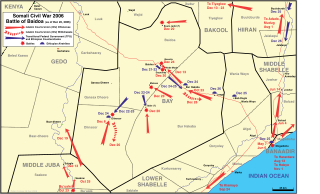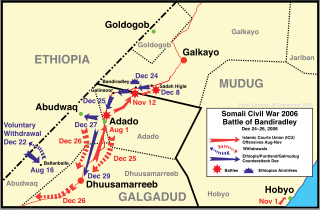Related Research Articles

Ali Mohammed Gedi, popularly known as Ali Gedi, is a Somali politician who was the Prime Minister of the Transitional Federal Government (TFG) of Somalia from 2004 to 2007. He was relatively unknown in political circles upon his appointment as prime minister in November 2004. He is affiliated with the Abgaal subclan of Mogadishu's Hawiye clan, one of Somalia's four most powerful clan 'families'. He narrowly survived a suicide attack at his home that left at least seven people dead on June 3, 2007. Gedi was widely viewed as corrupt, and was replaced by Nur Hassan Hussein as PM during late 2007.
Hussein Mohamed Farrah Aidid is the son of General Mohamed Farrah Aidid. His father was leader of the Somali National Alliance (SNA), the faction that fought UNOSOM II and US forces during 1993.

The Somali Warlord Alliance, officially called the Alliance for the Restoration of Peace and Counter-Terrorism, was a Somali alliance created by various Somali warlords and businessmen with the backing of the American Central Intelligence Agency in order to challenge the emerging influence of the Islamic Courts Union during the Somali Civil War.
Muse Sudi Yalahow born Mogadishu was a Trade Minister in the Transitional Government of Ali Mohammed Ghedi. He was dismissed in June 2006 after ignoring government requests to halt fighting with the Islamic Courts Union militia.

The Second Battle of Mogadishu was fought for control of Somalia's capital city, Mogadishu. The opposing forces were the Alliance for the Restoration of Peace and Counter-Terrorism (ARPCT), and militia loyal to the Islamic Courts Union (ICU). The conflict began in mid-February 2006, when Somali warlords formed the ARPCT to challenge the ICU's emerging influence. The ICU's influence was largely generated by wealthy financial donors who sought to enable the Islamic Courts Union to seize power in the country to bring stability. The battle is referred to as the Second Battle to distinguish it amongst the nine major Battles of Mogadishu during the decades-long Somali Civil War.
Mohamed Botan was a Somali rebel leader, formerly based in Mogadishu, and a former member of the Somali Transitional Government, in which he was minister for the disarmament of militias. He was also a member of the Alliance for the Restoration of Peace and Counter-Terrorism (ARPCT), a group of warlords opposed to the Islamic Court Union and allegedly financed by the United States.

The Islamic Courts Union was a legal and political organization founded by Mogadishu-based Sharia courts during the early 2000s to combat the lawlessness stemming from the Somali Civil War. By mid-to-late 2006, the Islamic Courts had expanded their influence to become the de facto government in most of southern and central Somalia, succeeding in creating the first semblance of a state since 1991.

The Transitional Federal Government (TFG) was internationally recognized as a provisional government of the Somalia from 14 October 2004 until 20 August 2012, when its tenure officially ended and the Federal Government of Somalia (FGS) was inaugurated.

The 2006 Islamic Courts Union offensive is the period in the Somali Civil War that began in May 2006 with the Islamic Courts Union's (ICU) conquest of Mogadishu from the Alliance for the Restoration of Peace and Counter-Terrorism (ARPCT) and continued with further ICU expansion in the country. Following the outbreak of the war on December 21, 2006; by December 24, direct Ethiopian intervention in the conflict in support of the Transitional Federal Government (TFG) was no longer denied by the Ethiopian government. The Eritrean government denied any involvement despite Ethiopian claims to the contrary.

The Battle of Baidoa began on 20 December 2006 when the Somali transitional federal government forces (TFG) allied with Ethiopian forces stationed there attacked advancing Islamic Courts Union (ICU) forces along with 500 alleged Eritrean troops and mujahideen arrayed against them.

The Battle of Bandiradley in Somalia began on December 23, 2006, when Galmudug and Ethiopian forces, along with faction leader Abdi Qeybdid, fought Islamic Courts Union (ICU) militants defending Bandiradley. The fighting pushed the Islamists out of Bandiradley and over the border south into Adado district, Galgadud region, by December 25.

The fall of Mogadishu occurred on 28 December 2006, when the Ethiopian National Defence Forces (ENDF) advanced into the capital to install the Transitional Federal Government (TFG). The Islamic Courts Union (ICU), which had controlled the capital since June 2006, withdrew from the city after a week of fighting ENDF/TFG forces in southern and central Somalia.
Mohamed Qanyare Afrah (Somali: Maxamed Qanyare Afrax, Arabic: محمد افراح قنياري} was a Somali faction leader and politician who was based south of Mogadishu in the Daynile District. He came in third position in Somalia's first election as a federal country on 10 October 2004 and was subsequently appointed minister of public security in the government of Prime Minister Ali Mohammed Ghedi, He served as minister of security in 2006 but was dismissed after ignoring calls by the Prime Minister Ali Mohammed Ghedi to stop fighting forces of the Islamist Courts. He continued to participate actively in Somali political affairs being reelected to the first post transitional federal parliament of Somalia as a member of parliament, he resigned from his seat representing his clan in the summer of 2013, his seat in the Federal Parliament of Somalia was taken over by his son Cabdiweli Mohamed Qanyare.

The transitional federal government (TFG) was the government of Somalia between 2004 and 2012. Established 2004 in Djibouti through various international conferences, it was an attempt to restore national institutions to the country after the 1991 collapse of the Siad Barre government and the ensuing Somali Civil War.
Yusuf Mohammed Siad Indhacade, aka "Inda'ade" is a Somali former Minister. In 2011 he was a General in the Somali National Army. He hails from the Ayr sub-clan, part of the Habar Gidir, which is a branch of the Hawiye clan. For a short period he was Somali Minister of Defence (Somalia).

Omar Mohamud Mohamed is a Somali politician and former warlord known as Omar Finnish. He is the former Mayor of Mogadishu and Governor of Banaadir. He was appointed on 22 August 2019 by Somalia President Mohamed Abdullahi Mohamed. He stepped down on 7 September 2022 after the new president of Somalia, Hassan Sheikh Mohamud, reappointed Yusuf Hussein Jimaale as the new mayor of Mogadishu and Governor of Banaadir.
The timeline of events in the War in Somalia during 2006 is set out below.

The timeline of events in the War in Somalia during 2007 is set out below.
General Ismail Qasim Naji in Borama, Somalia was the chief of staff of the Transitional Federal Government (TFG) of Somalia and currently the Somali ambassador in Oman. He has served as a senior officer of the Somali army since the administration of Siad Barre, who was removed from power in 1991. Before the formation of the TFG, he also commanded the army of the predecessor Transitional National Government (TNG) of Somalia between 2002 and 2004.

The 2009 timeline of events in the Somalia War (2006–2009) during January 2009 is set out below. From the beginning of February the timeline of events in the Somali Civil War (2009–present) is set out following the conclusion of the previous phase of the civil war.
References
- ↑ Demobilization of the Militia Archived 2007-06-29 at the Wayback Machine Somali Joint Needs Assessment (MS Word Doc)
- ↑ Disarmament, Demobilization & Reintegration: Somalia Militia Archived 2007-06-29 at the Wayback Machine Nairobi Kenya, May 2005 (MS Word Doc)
- ↑ Somalian resistance out gunned Archived 2006-08-19 at the Wayback Machine AP, United Nations, Taipei Times
- ↑ Islamic Leader Talks of Peace in Somalia Archived 2006-11-20 at the Wayback Machine Associated Press
- ↑ "Battle-scarred nation is at peace with itself... but still facing war" [ dead link ], Martin Fletcher, The Times , December 16, 2006
- ↑ Somalia: News summary for December 29, 2006 Archived 2007-01-17 at the Wayback Machine SomaliNet
- ↑ AP Interview: Former warlord calls government control of Somali capital an illusion Archived 2008-10-16 at the Wayback Machine Associated Press
- ↑ Somalia govt orders Puntland to surrender weapons Archived 2007-01-06 at the Wayback Machine Garowe Online
- 1 2 Somali prime minister orders complete disarmament Associated Press
- ↑ Islamic militants in Somalia flee after stronghold falls Archived 2007-01-04 at the Wayback Machine Associated Press
- ↑ Somali government to disarm the civilian population in three days [usurped] Shabelle Media Network
- ↑ Somalia: Premier Gedi meets with Ayr sub-clan over the disarmament Archived 2008-10-14 at the Wayback Machine SomaliNet
- ↑ Somalia: Former warlord says no revenge against Islamists [usurped] Shabelle Media Network
- ↑ Everyone in Somalia's capital has a gun– everyone, that is, but the police Archived 2008-02-13 at the Wayback Machine Associated Press
- ↑ Somalia: Ex-warlords question calls for public disarmament [ permanent dead link ] Garowe Online
- ↑ Somalia: Arms surrendered to the government for the first time [usurped] Shabelle Media Network
- ↑ Somali Government forces start disarming residents in Jilib [usurped] Shabelle Media Network
- ↑ Somalia: Militias burn vehicle, wound 3 at illegal roadblock [ permanent dead link ] Garowe Online
- ↑ Truck attacked in Somalia, many wounded Archived 2007-09-30 at the Wayback Machine Reuters
- ↑ Somalia: Two people are injured after armed militias open fire at a truck [usurped] Shabelle Media Network
- ↑ "Somalia: Puntland forces to assist in Mogadishu disarmament". Garowe Online. 2006-01-05. Retrieved 2006-01-06.[ dead link ]
- ↑ "Somalia: 4 dead in clan militia fighting". Garowe Online. 2006-01-05. Retrieved 2006-01-06.[ dead link ]
- ↑ "Somalia: Riots in Mogadishu, disarmament postponed". Garowe Online. 2006-01-06. Archived from the original on January 8, 2007. Retrieved 2006-01-06.
- ↑ "Somalia: Seven demonstrators injured in Mogadishu". Shabelle Media Network. 2006-01-06. Archived from the original on September 30, 2007. Retrieved 2006-01-06.
{{cite news}}: CS1 maint: unfit URL (link) - ↑ "Somali warlords agree to disarm as government troops capture last Islamic holdout in south". Associated Press. 2007-01-12. Archived from the original on 2013-02-02. Retrieved 2007-01-12.
- ↑ "Somalia leaders, ex-warlords reach deal as fighting kills 7". Garowe Online. 2007-01-12. Retrieved 2007-01-12.[ dead link ]
- ↑ "Martial law declared in Somalia". BBC. 2007-01-13. Archived from the original on 2007-01-15. Retrieved 2007-01-16.
- ↑ "Martial law for Somalia after Islamists flee capital". Reuters. 2006-12-29. Archived from the original on 2007-01-02. Retrieved 2007-01-16.
- ↑ "Somalia: Warlords lay down weapons". SomaliNet. 2007-01-17. Archived from the original on 2008-10-14. Retrieved 2007-01-17.
- ↑ "Warlords finally surrender their arms to the Somali TFG". Shabelle Media Networks. 2007-01-17. Archived from the original on September 30, 2007. Retrieved 2007-01-17.
{{cite news}}: CS1 maint: unfit URL (link) - ↑ "Somali president calls for national reconciliation conference: Official". Garowe Online. 2007-01-30. Retrieved 2007-02-01.[ dead link ]